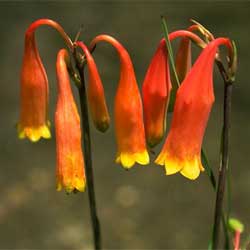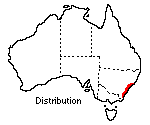Blandfordia nobilis
 |
Christmas Bell
Christmas Bell (Blandfordia nobilis) is a small plant of the Lily family, one of only four species in this eastern Australian group. It entered cultivation in 1803 as a glasshouse plant in England, followed by the other Blandfordia spp. They are popular in Australia as wildflowers, but only native plant enthusiasts cultivate them in home gardens.
The species grows wild in the sandstone country of New South Wales, in coastal
heath and in the mountains, but not in cold, dry regions. It is found also in
open patches of pure sand with good rainfall, in water seepage areas and in
swampy heath.
 Among
the many beautiful heath species, Christmas Bell is prominent in form and colour
with its erect stems and bicoloured, firm bells. Nothing else has its tones
of orange, through scarlet to blood-red tipped with saffron yellow, or paler
tints of these including salmon pinks *. Flowers
entirely yellow are seen occasionally.
Among
the many beautiful heath species, Christmas Bell is prominent in form and colour
with its erect stems and bicoloured, firm bells. Nothing else has its tones
of orange, through scarlet to blood-red tipped with saffron yellow, or paler
tints of these including salmon pinks *. Flowers
entirely yellow are seen occasionally.
Plants are dainty in appearance, but robust, with thick fibrous roots, not bulbs, which can spread to form strong and long-lived clumps in the right garden conditions. They brighten small spaces in the garden during summer, are unaffected by heat waves, and can have a permanent place in a deep rockery pocket, increasing without disturbance. Deep, sandy, lime-free soil is needed, and in Canberra the plants benefit from the general shelter of nearby taller herbs and shrubs.
Stiff grassy leaves form compact clumps up to half the height of the flower stems. They are about 1 cm wide with rough margins which are most interesting when magnified, being unevenly notched or undulating with some blunt or curved teeth, often all on one leaf.
The bells are 4 cm long and about 1cm wide in a cluster near the top of the main stem, hanging on curved stems. They are thick, fairly shiny and scentless.
In the Australian National Botanic Gardens, several groups are thriving, raised from seed, and sown under glass while fresh. This germinated at intervals yielding several hundred plants which were potted up singly, hardened off in the large airy shade house and planted out at about 18 months old. Great care was taken at all stages not to disturb the roots. Some plants produced the first small flowering stems from 18 months later.
One group is in an open bed with no mulch, but topped with several centimetres of fine local river sand which is often hot and dry between the regular waterings. The bed slopes gently and there has been some washing away in sudden storms. As a result not all plants have survived here, though a number are thriving with strong upright stems nearly 80 cm high.
The best examples have been on the bank of a shallow hollow at the foot of the gardens where the soil is naturally deep and light with fairly constant moisture, in full sun but with shrubs behind. It is an area of natural water seepage used for moisture-loving and bog plants. Other specimens may be found in the Sydney region Flora sections.
Clumps now flowering have up to six stems each and the first stems of the season are the strongest, over 80 cm high and almost woody. These have over 30 bells to the cluster. They open from mid-December and the season continues with smaller later stems of five or more bells until February. They do not fade, even during high temperatures.When seed is set the long capsules turn to point upwards as stiffly as the flowers point down. This is a device in nature to aid the free scattering of seeds.
Based on text by ANBG staff (1973)
*Horticultural Colour Chart,
Royal Horticultural Society, London 1966 - red 39A with yellow-orange 21B and
orange-red 33B with yellow-orange 21C
Name meaning: Blandfordia nobilisBlandfordia - after George Spencer-Churchill (1766-1840), Marquis of Blandford; nobilis - famous, noble |
![An Australian Government Initiative [logo]](/images/austgovt_brown_90px.gif)

